 Eustis Estate
Eustis Estate
Changing Landscape
Sculpture at the Eustis Estate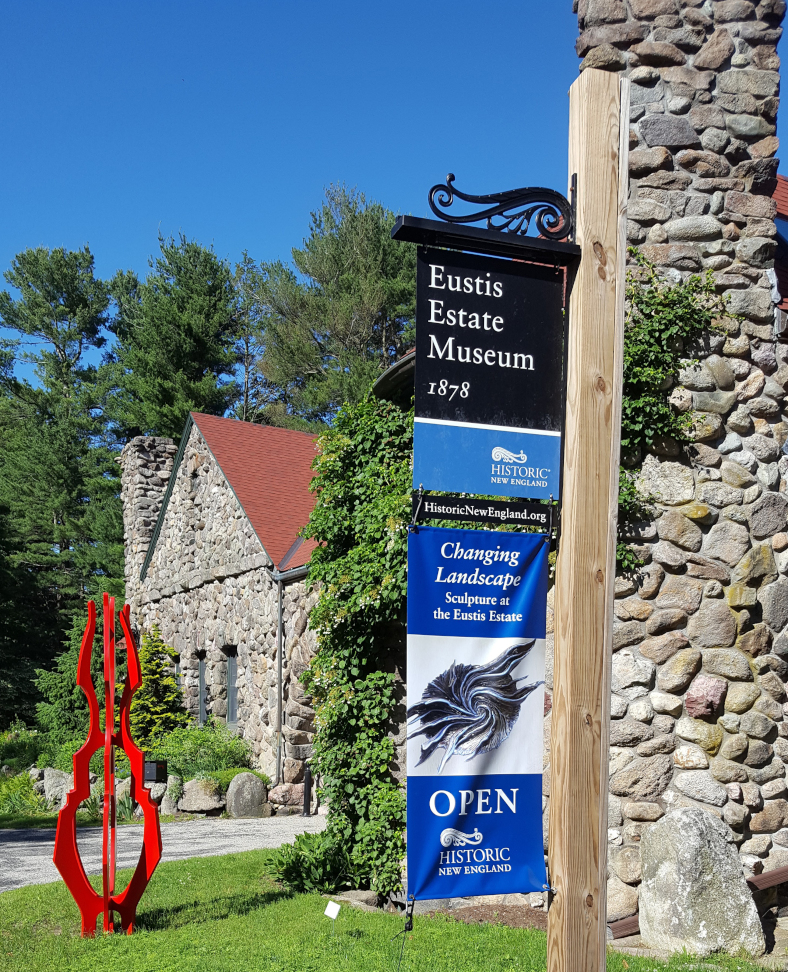
Historic New England and New England Sculptors Association (NESA) present Changing Landscape: Sculpture at the Eustis Estate, June 1 – November 3, 2019.
More than eighty contemporary sculptures by members of NESA fill the grounds and the three galleries on the second floor of the Eustis Estate. The estate, in an eighty-acre picturesque setting at the base of the Blue Hills, is the perfect backdrop for art that uses material related to landscape and the environment.
Changing Landscape explores how sculpture has an impact on its environment and enhances a visitor’s experience. The art can become an integral part of a garden, start a path, or create a focal point. Visitors can walk among the strategically placed sculptures and see their surroundings in a new way. The theme and location of the show connect the past to the future and represent Historic New England’s commitment to landscape preservation.
Below you will find additional material from the sculptors of some of the pieces in the exhibition including artist statements, process and technique information, audio and video interviews, and additional images.
Outdoor Sculpture Map
Click the dots on the map for information about the outdoor sculptures.

1. David Adilman - Backstroker

2. Anne Alexander - Guandul

3. Craig Anderson - No 2

4. Serena Bates - Stellar Expectations
5. Thomas Berger - Breaking Dormancy
6. Thomas Berger - Offering

7. Gilbert Boro - Ball, Beams & Curves, IV/9 Violet Blue

8. Janice Corkin Rudolf - Arabesque

9. Janice Corkin Rudolf - Venus

10. Josie Dellenbaugh - Peaceable Francis

11. Kevin Duffy - Contemplation

12. Kevin Duffy - Piqued Cube
13. Shawn Farrell - Nigella Damascena/Love In A Mist

14. Joseph Ferguson - Seven Stars

15. Barbara Fletcher - Look Deep into Nature

16. Alfred Glover - Garden Gate

17. Alfred Glover - Palms Tree With Heron

18. Douglass Gray - 79 Degrees

19. Cate Irvine - Oak Leaf

20. Madeleine Lord - Donkey

21. Madeleine Lord - Swan Lake

22. Philip Marshall - Care

23. Philip Marshall - Metro

24. Philip Marshall - Next Stop Shibuya

25. Morris Norvin - Flotsam and Jetsam

26. Morris Norvin - The Discarded

27. Roe Osborn - SlipSliding II

28. Stacy Savage - Turbulence

29. Antoinette Schultze - Couplet

30. Andreas von Huene - Khamsin

31. Andreas von Huene - Owl Gliding

32. Andreas von Huene - Pull of the Moon

33. Andreas von Huene - Walk the Earth

34. Mark Wholey - Red Spirit

35. Joyce Audy Zarins - Safety Net

36. Melanie Zibit - Echo
to learn more
Couplet
Antoinette Schultze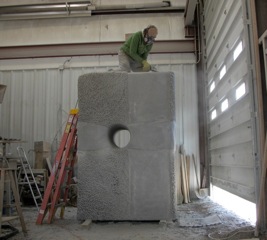
Antoinette Schultze’s Couplet, made of granite, glass, and steel, is shaped to exhibit comfort in a relationship. The two stones are set apart with steel beams, creating space and tension stemming from the balancing of the weight enabling this sandwiched space to exist. Listen to the artist in her own words below.
Backstroker
David AdilmanThis piece started out with a simple curve. That curve became the arched back of a backstroker in the ocean. Click through the images to see the work in progress and listen to the artist talk about the piece below.
Backstroker: Beginning
Philip Marshall
Philip Marshall has five pieces in the exhibition: three outdoors and two indoors. Listen to the artist speak about his works below the next gallery of images.
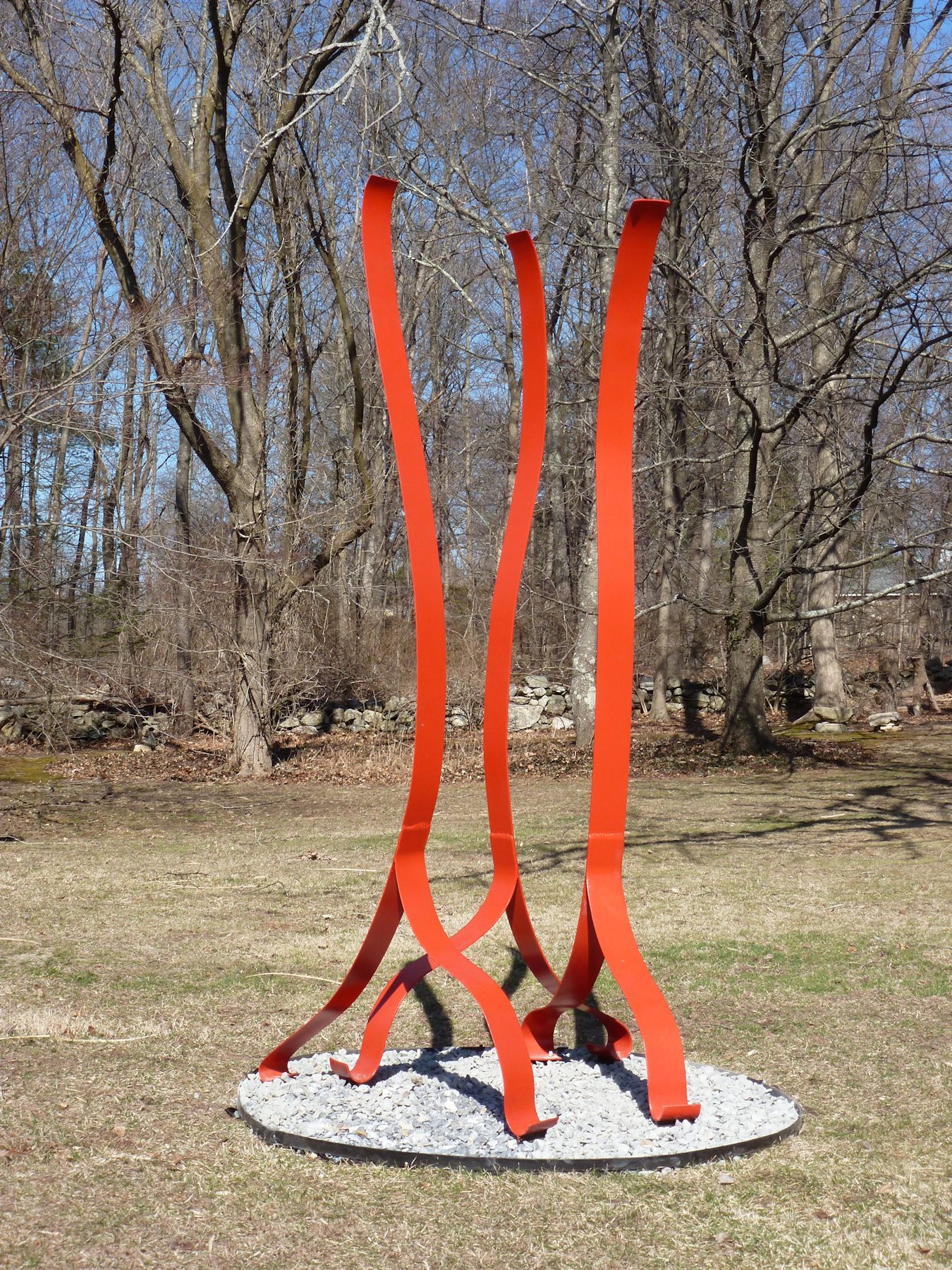
Metro. This installation of “Metro” is part of a larger project in two- and three-dimensional media prompted by my experiences in some of the cities of Europe and the Middle- and Far-East. This project includes my exploration of the loss of individuality of people in the seething mass of humanity of a great metropolis. It is inspired by the rush-hour foot traffic I have encountered in such cities as London, Tokyo and Jakarta. I have the impression that the people, although often appearing visually similar, remain isolated individuals as they purposefully make their separate, but intersecting, ways to work.

Next Stop Shibuya 次渋谷 . Although executed as an abstract sculpture, now completed, it reminds me of my rush hour experiences on the Tokyo Metro and commuter trains. Being crushed together, often face-to-face with total strangers, too squeezed together to even breath properly, requires a mental preservation of personal space that is not possible physically. The outward curve of these two elements suggests to me the mental separation despite physical proximity that Tokyo, like almost all large cities, requires if one is to maintain one’s own individuality. Having been compressed into a railway car at Shinjuku, and being pushed further in at each stop, hearing “The next stop is Shibuya”, my destination, was a welcome announcement.
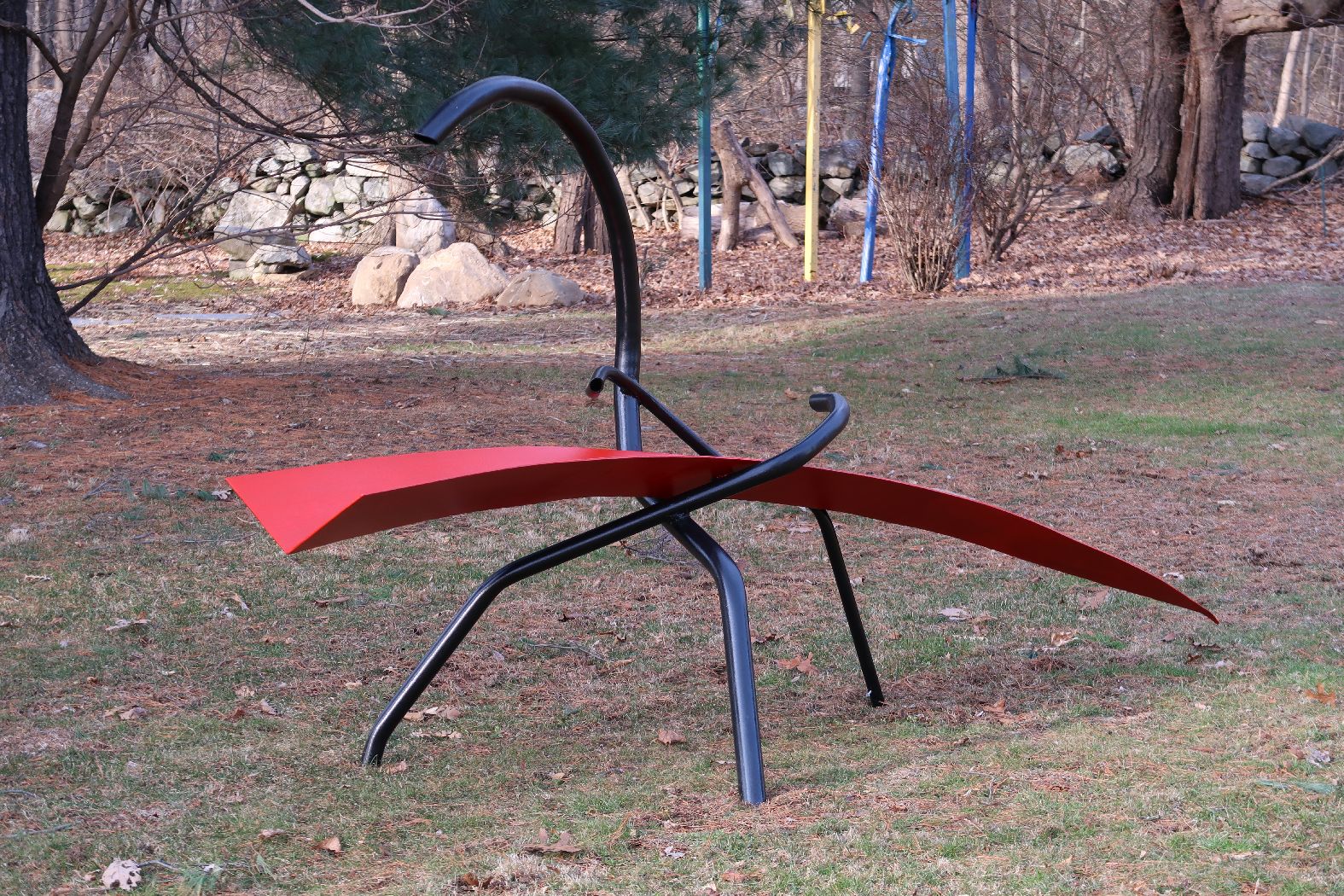
Care. I wanted to explore further the shape produced by joining two steel strips along a curved edge that I used in “Next Stop Shibuya”. This simple act of joining two simple shaped sheets can produce a three-dimensional object that reminds me of my times in Japan. I also wanted to challenge myself to create a horizontal piece, and to explore contrasting planes with tubes. The resulting arched shape of the sheets suggested to me a recumbent person, the tubing a caring other; I was reminded of the emotions provoked by “Pieta”. I have had difficulty settling on a title for this abstract piece that would not prejudice the viewer as the contrasting shapes may suggest conflict or tension to some, whereas the composition may suggest the opposite to others. Originally I painted the piece all black; I have repainted the arched element to create more presence and to emphasize that there are two elements that hint at two figures: one draped over the other.
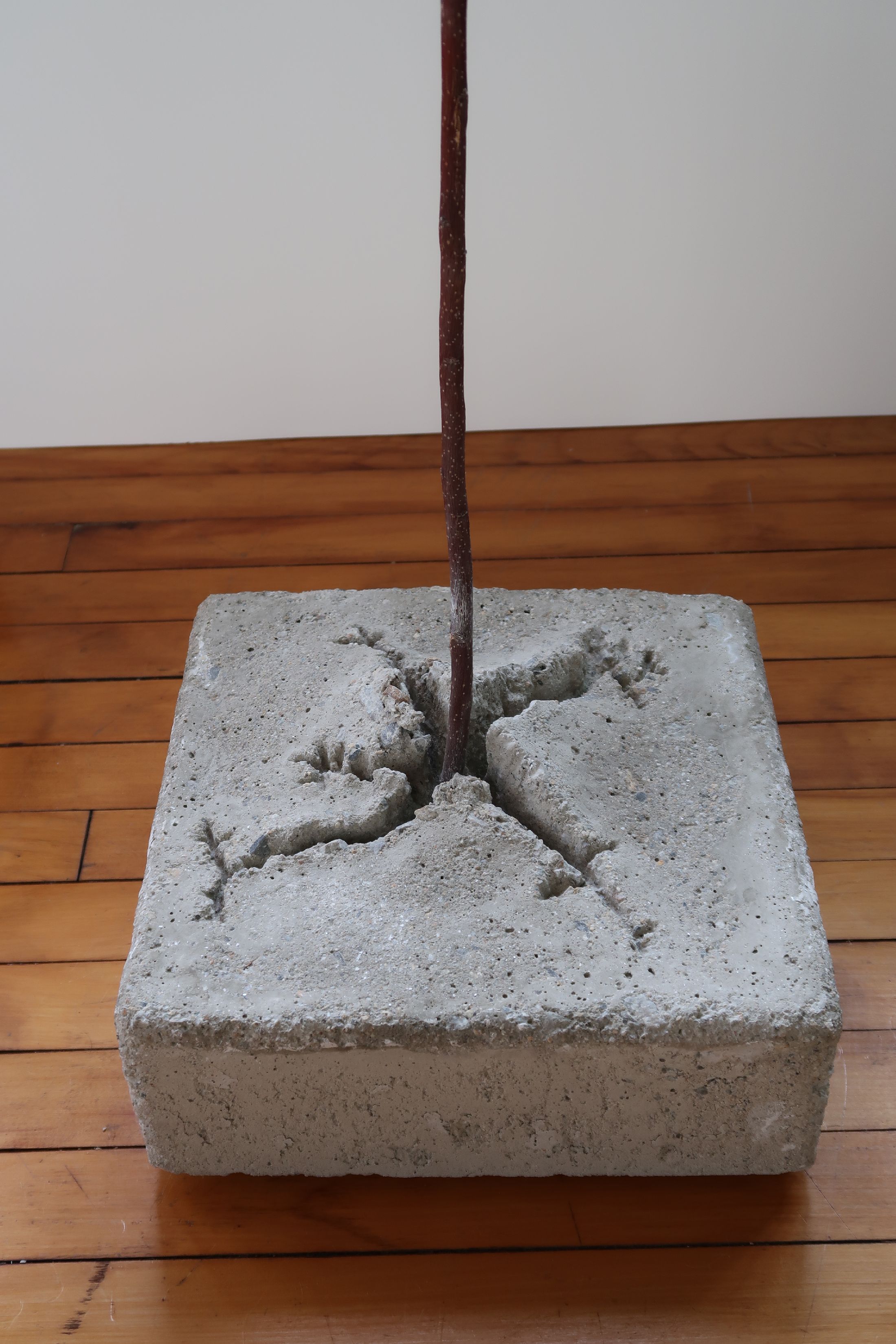
Natural Selection. Since the mid–20th century, concrete has replaced stone as the artist’s metaphor for enduring strength, and for the human taming and domination of nature. I am exploring the themes of “civilization’s” arrogance and self-justifying social order. Our ability to displace nature and destabilize the world’s ecology is very disturbing. However, I am heartened by nature’s resilience and persistence in re-taking the ground that it loses. One has only to see nature’s overwhelming of artifacts of past civilizations, the re-growth of New England’s forest, the grass on a rural road, or the pure riot of a tropical forest to realize that, despite our seemingly all-powerful efforts to impose everlasting marks on the environment, we are only temporary masters of our world. A frail sapling bursting through concrete to remind us of the temporal limits of our power is perhaps a spark of hope.
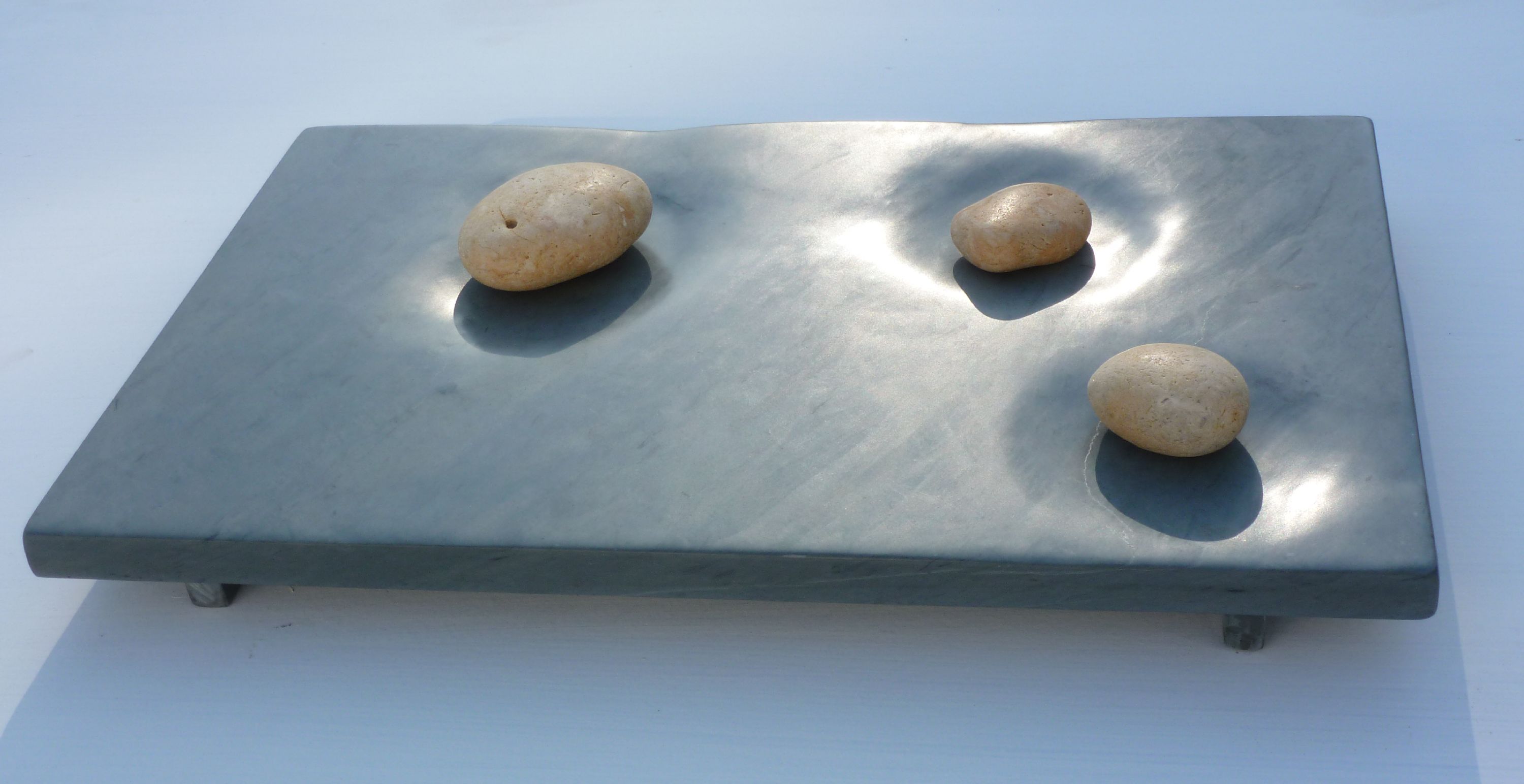
Resting Places. I created this piece for an art show for the visually–impaired, so I made it as a tactile piece to be touched. I wanted to contrast the silky-smoothness of the slate that I polished, with the rough texture of the stones that were naturally smoothed by being churned together for millennia by the grey English Channel. I had in mind the hollows that stones sometimes have made in rocks by their endless action in fast-moving water, or when used by ancient peoples over many generations for the repeated grinding of corn at the same location. I thought such stones looked as if they had nestled down to rest.
Look Deep Into Nature
Barbara Fletcher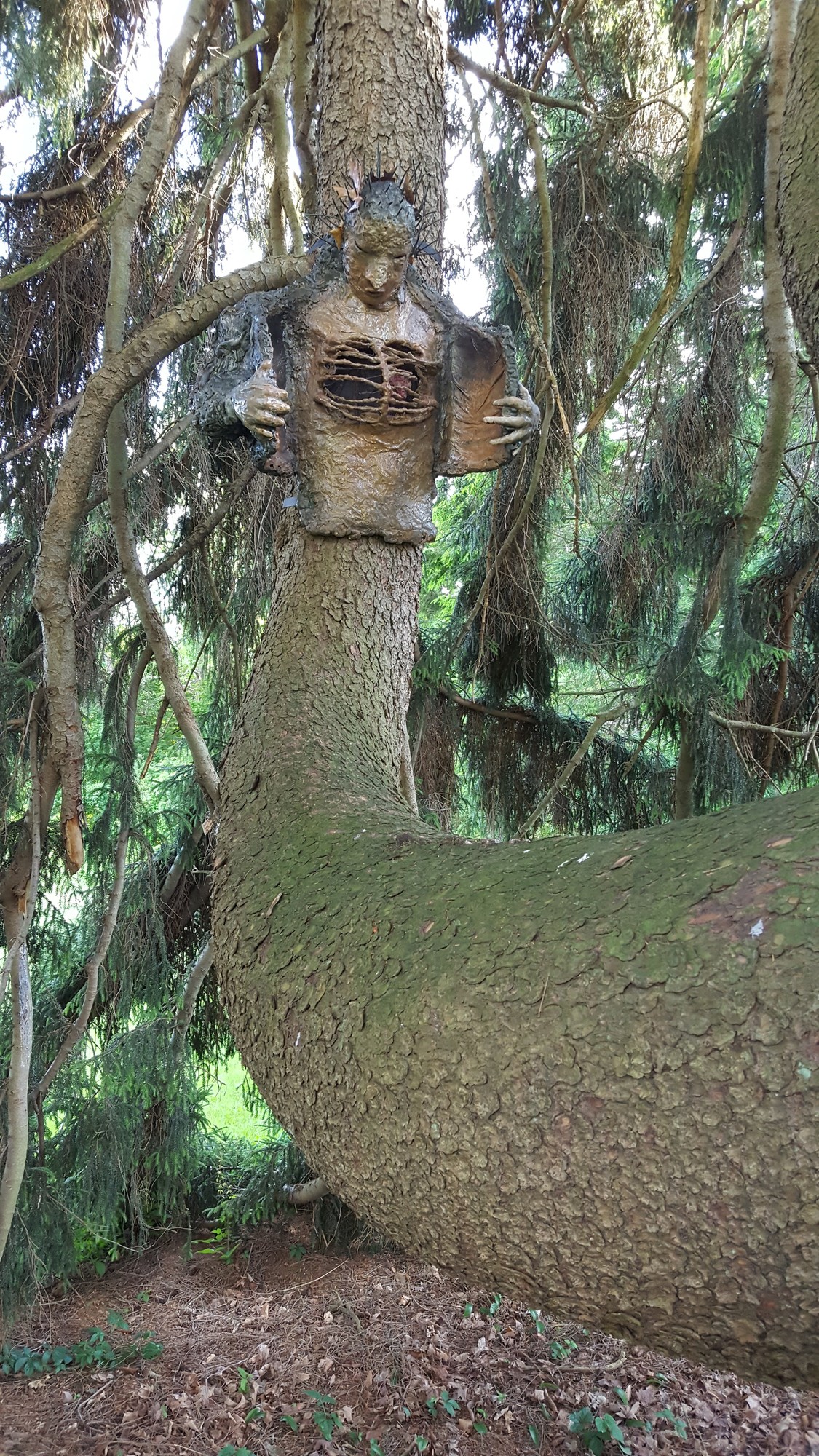
“I am a storyteller and an observer of nature and the nature of the human condition. Color, humor and animation are important aspects of my work. Growing up on a farm as a child I played and fantasized in the large barns in the back of my house. Working with my hands I assembled special environments for myself and these became my living sculptures.
As an adult I became a sculptor of paper and mixed media, creating environments on a larger scale. In recent years I have been very interested in environmental issues and much of my art reflects these themes sometimes in a fantastical way.
The title of this piece Look Deep into Nature is taken from a quote by Albert Einstein, “Look deep into nature and you will understand everything better.”
I believe that the power of human encounter with nature can be a religious experience. I believe nature is divine. Sadly it seems as if nothing is sacred today and trees and nature are threatened by climate change.”
Red Spirit
Mark Wholey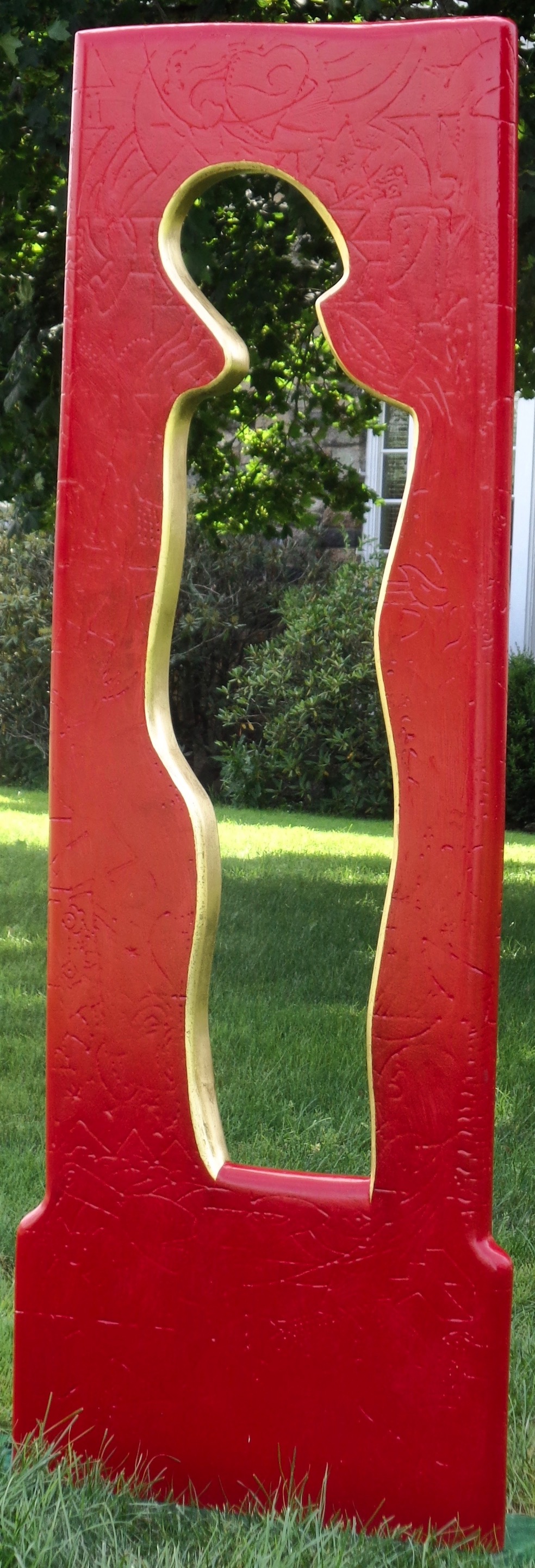
Red Spirit is a sculpture of a figure that is there and not there. It is inspired by observing a friend, an opera singer, standing before an audience, poised, collecting her thoughts. A poignant moment between emptiness and fullness. Nothing and something. The absent figure in the sculpture is the intangible. Inscribed around the missing figure are designs and symbols of tangible, everyday life, raising the question of who we are? What makes us who we are? I wanted the work to simultaneously express contemplation and inspiration. To let the observer fill the void and identify the figure. The sculpture is made of painted high density urethane and inscribed with 24K gold leaf to energize the form.
The poem below by Mark Strand speaks to this sculpture.
Keeping Things Whole
In a field
I am the absence
of field.
This is
always the case.
Wherever I am
I am what is missing.
When I walk
I part the air
and always
the air moves in
to fill the spaces
where my body’s been.
We all have reasons
for moving.
I move
to keep things whole.